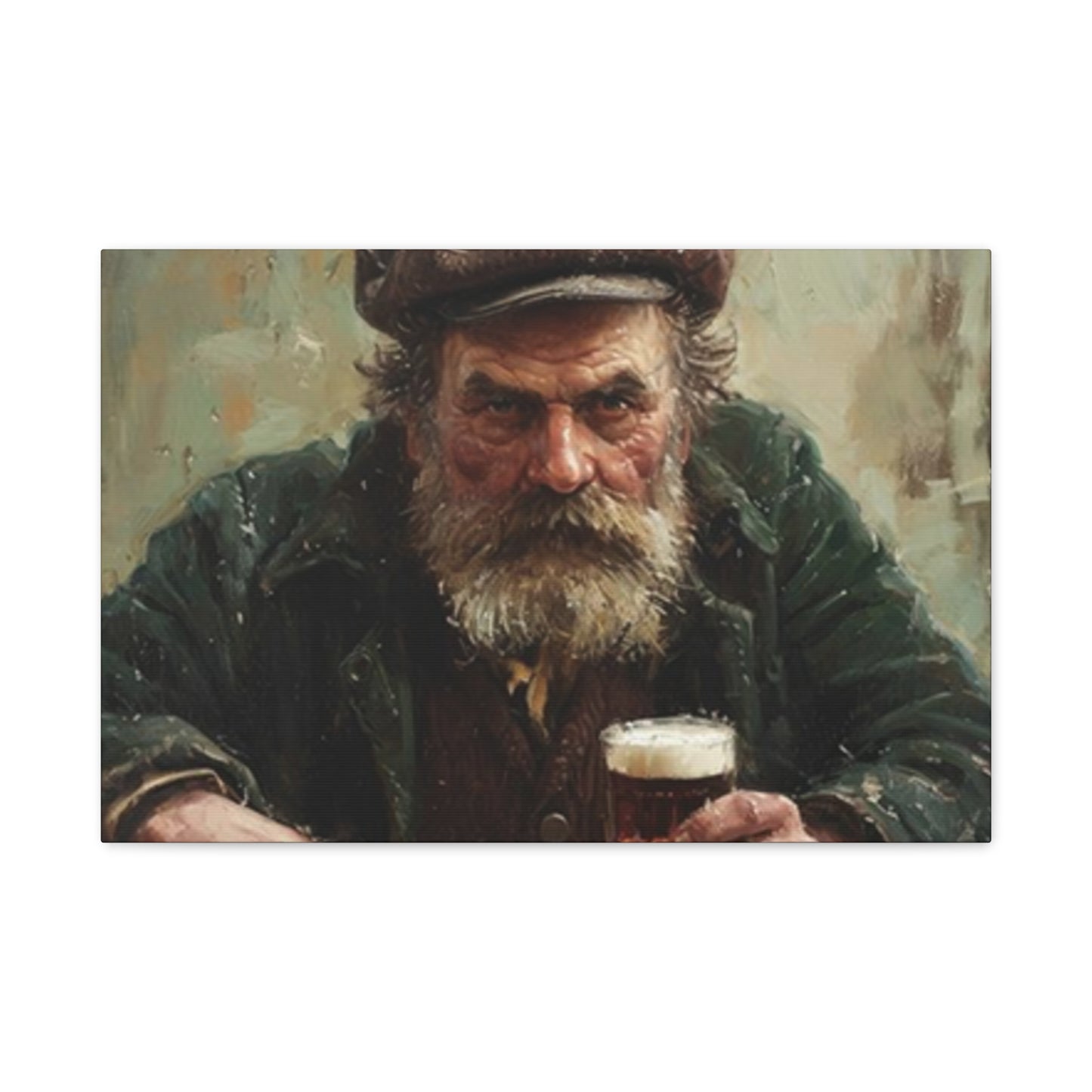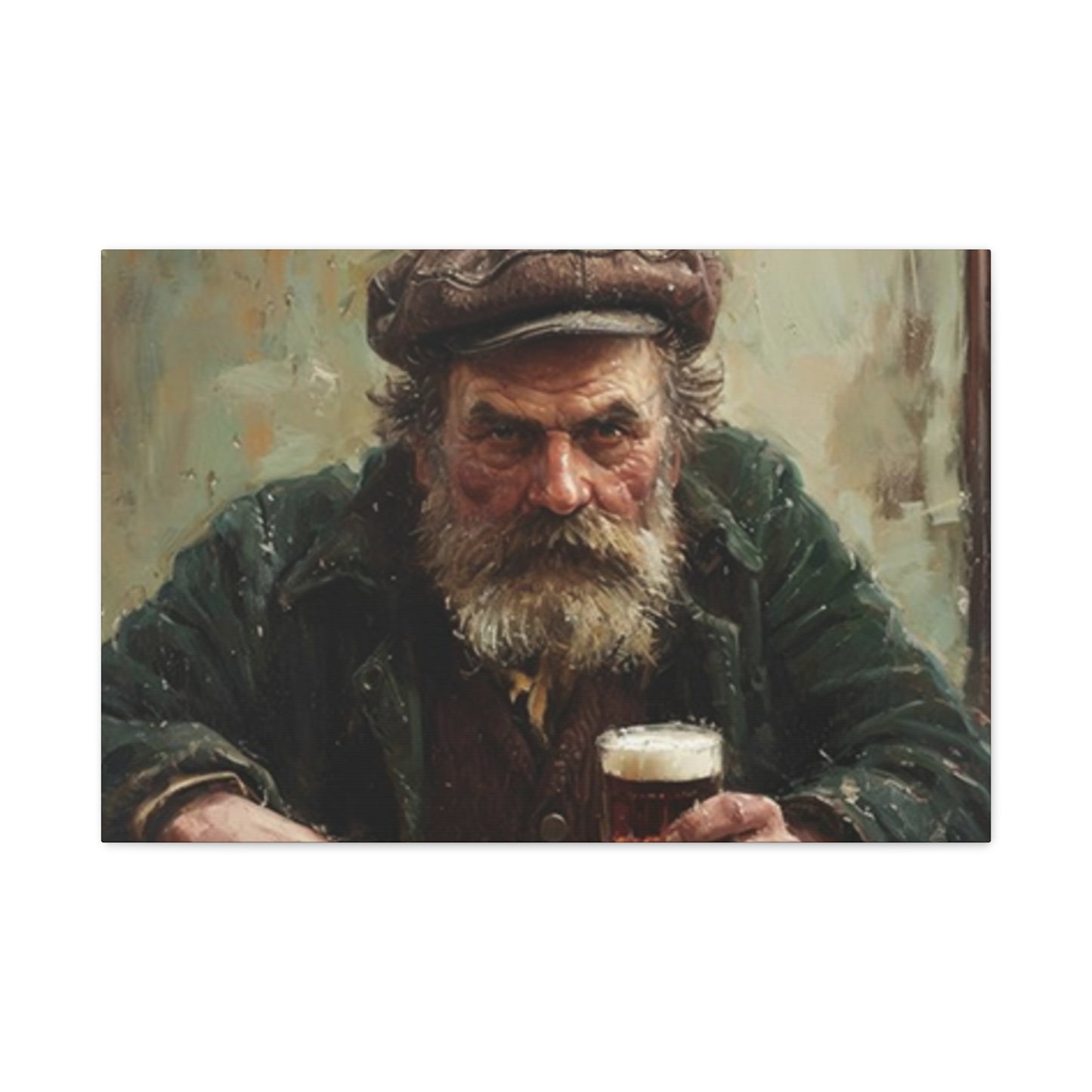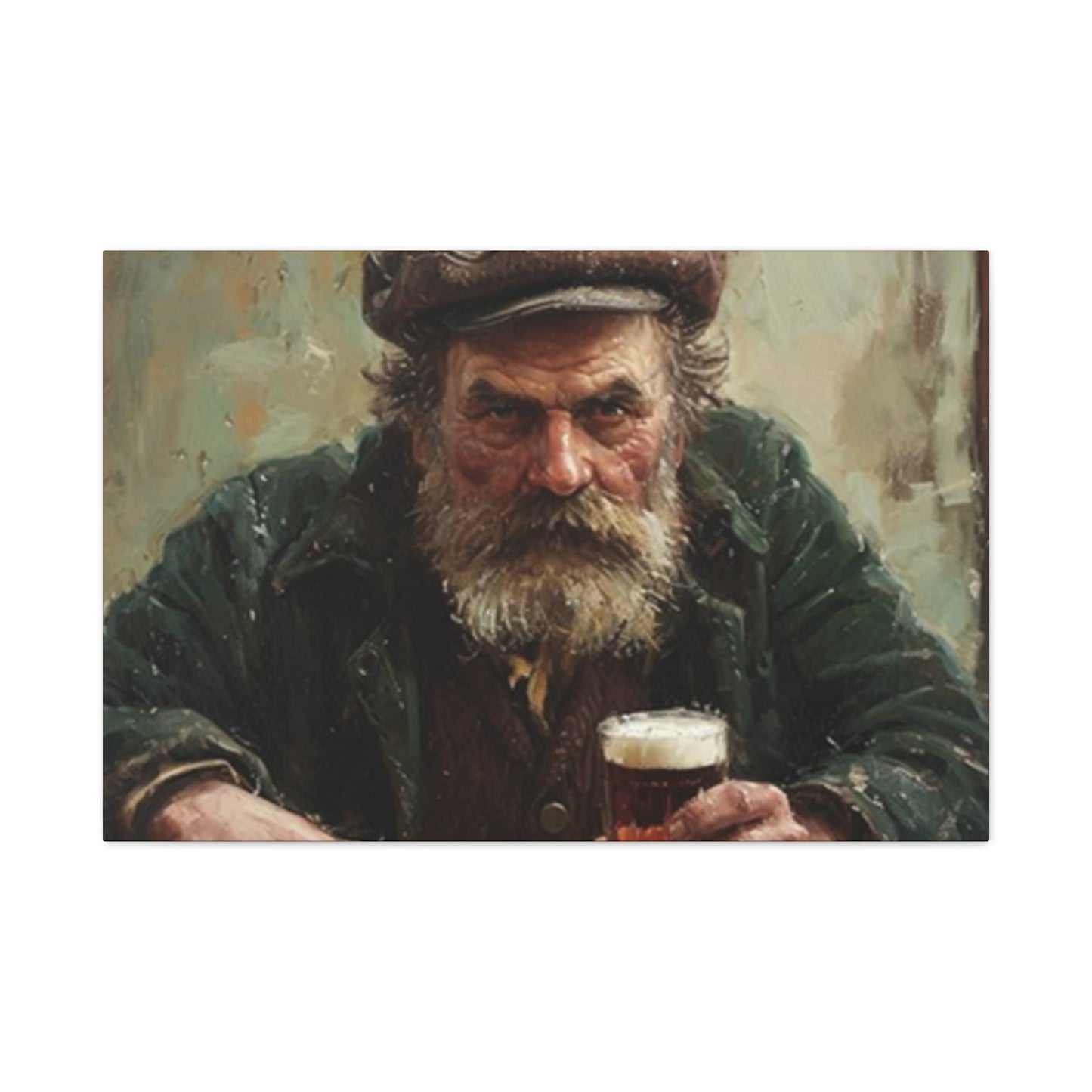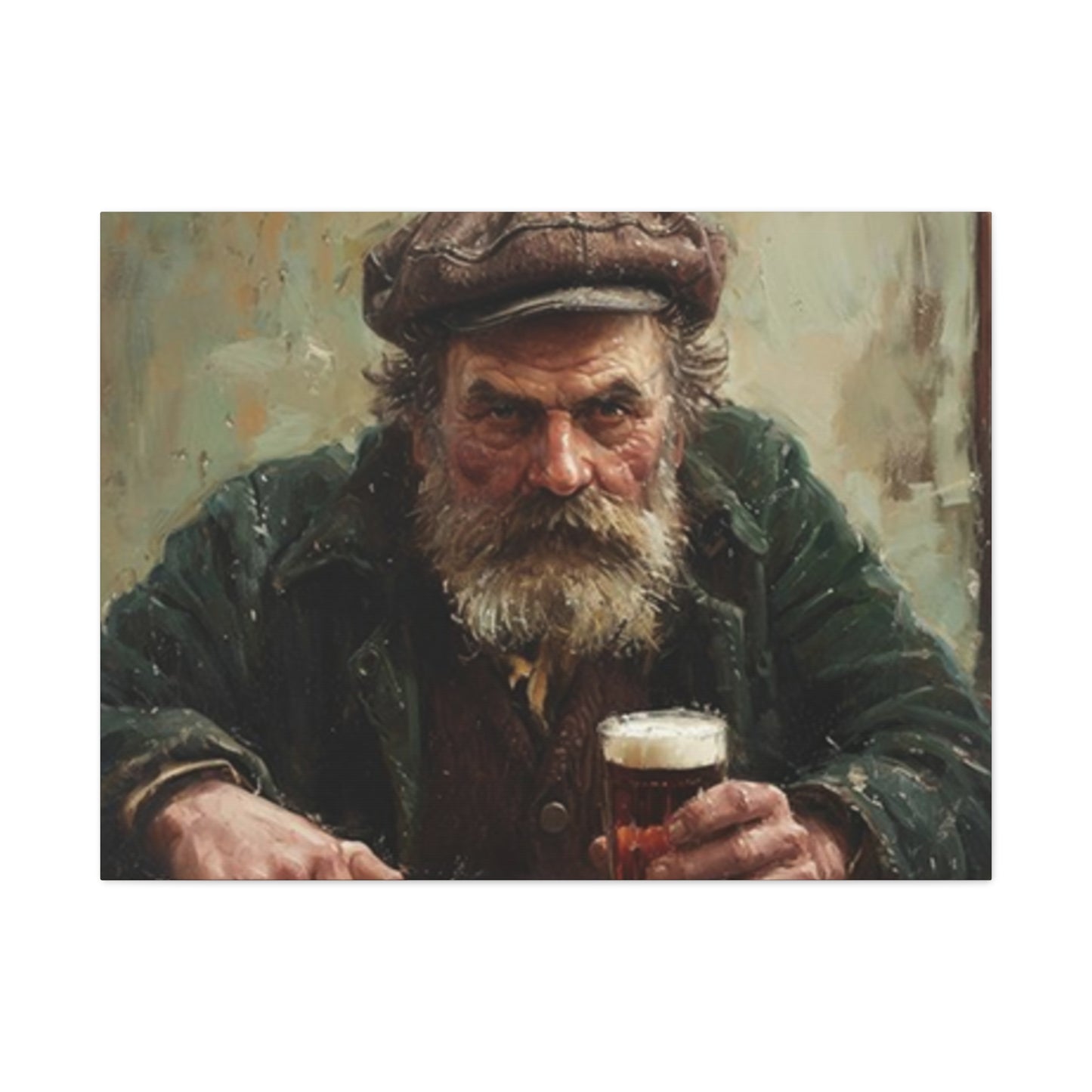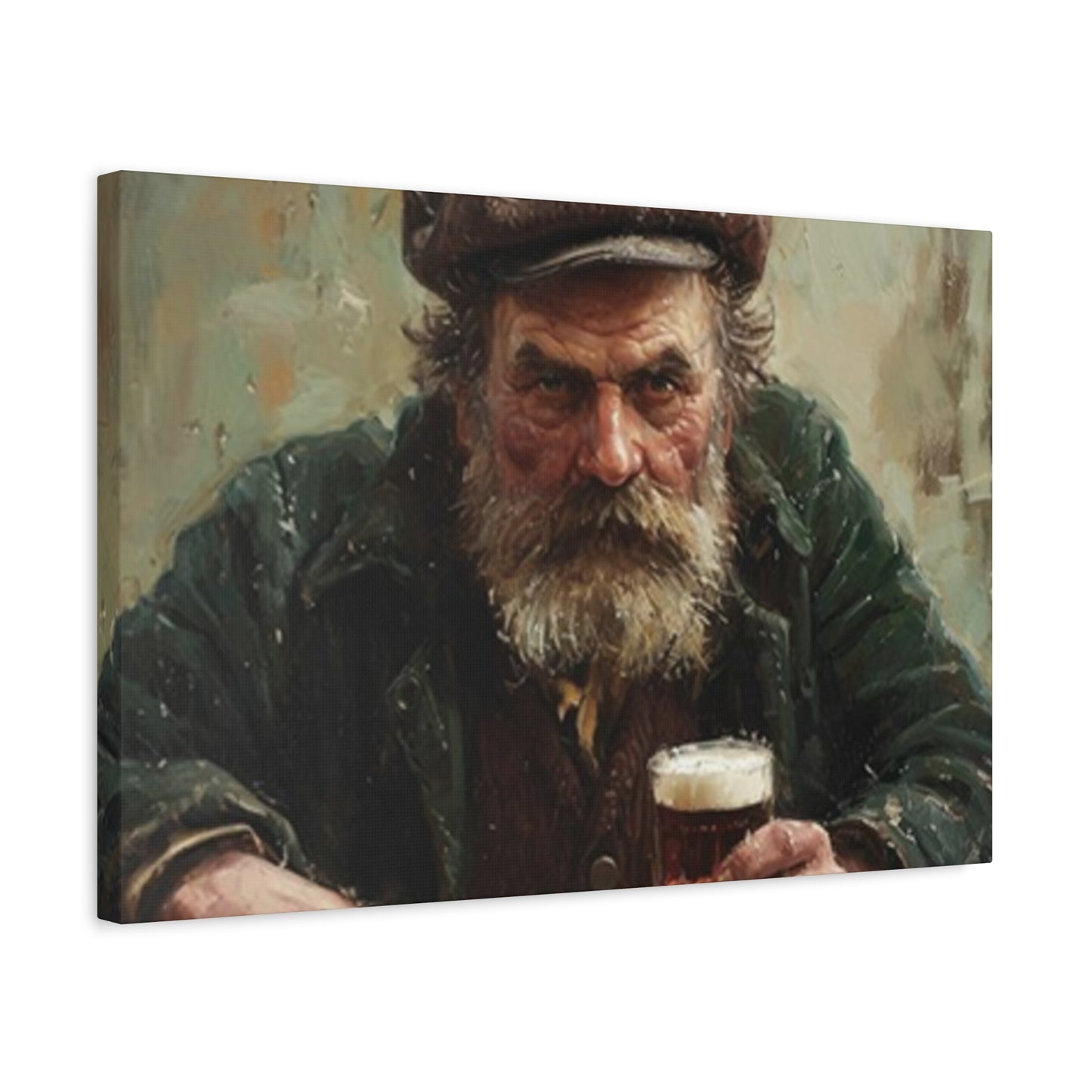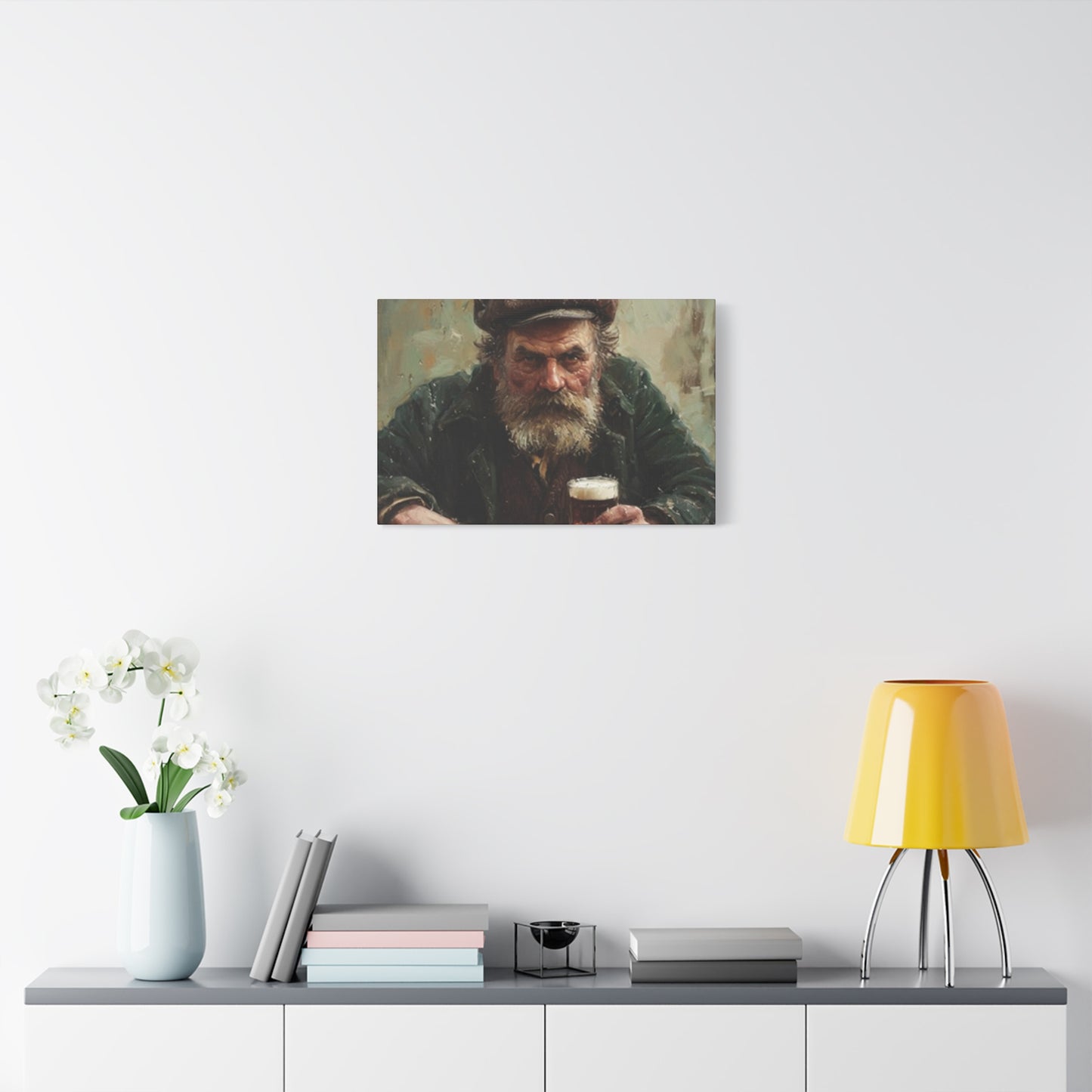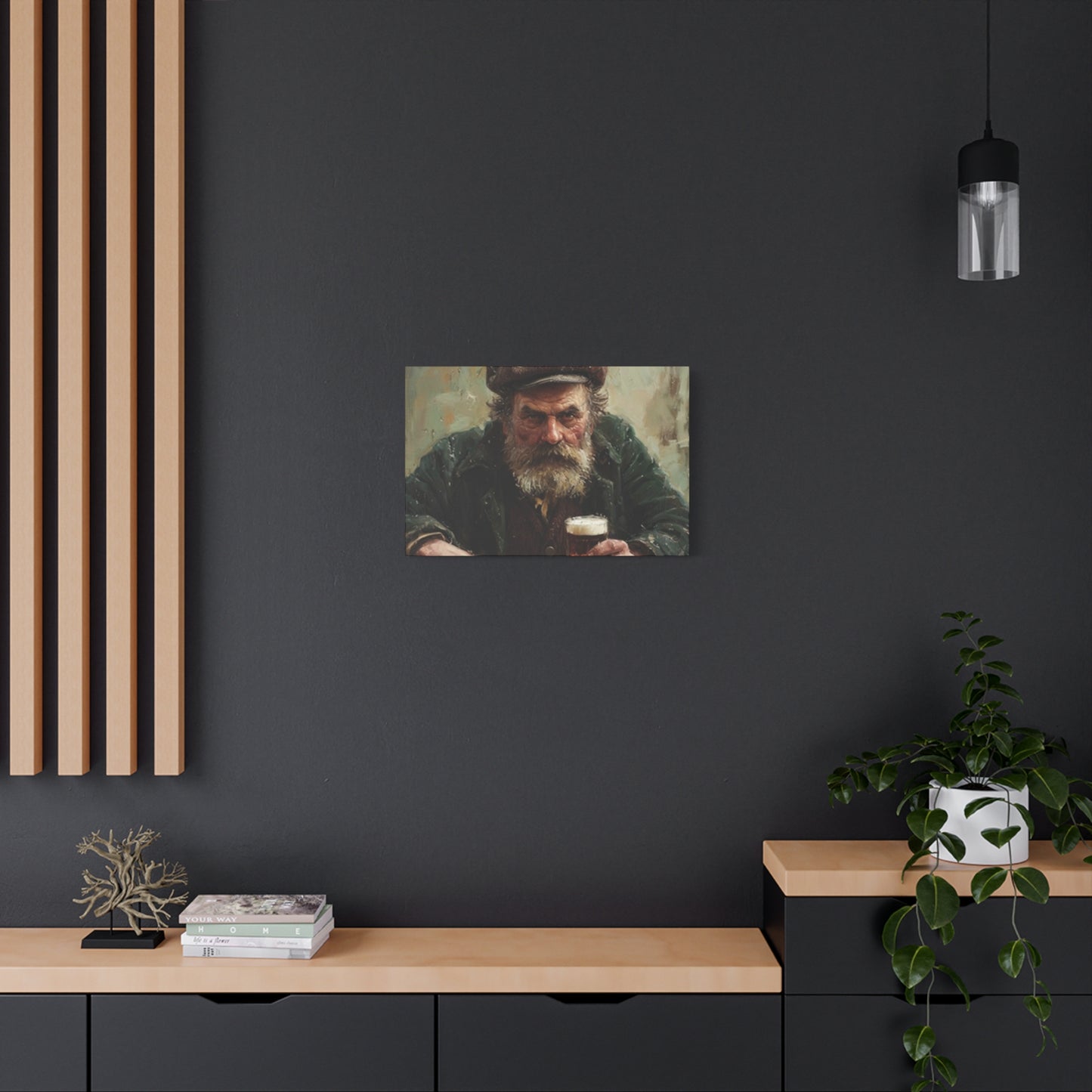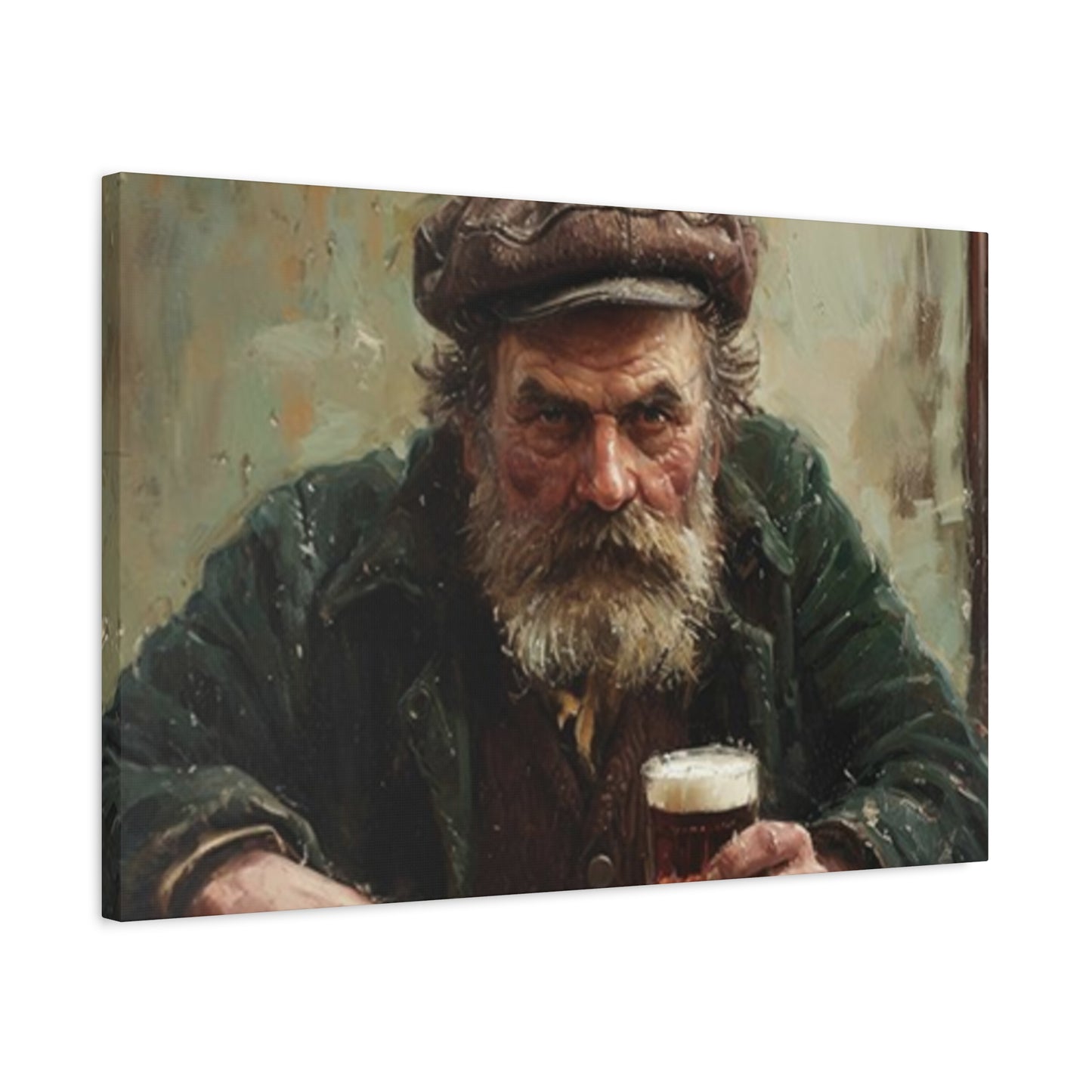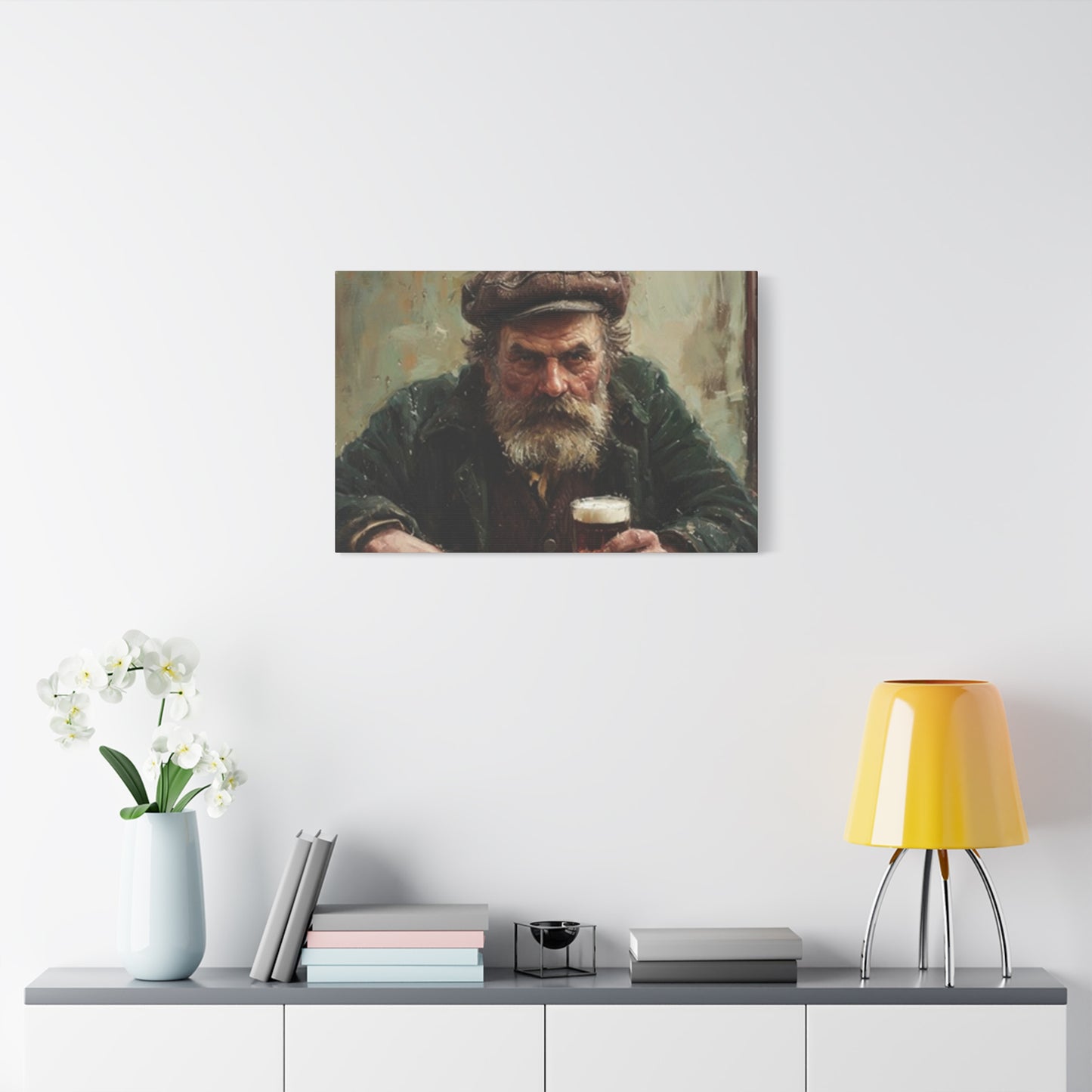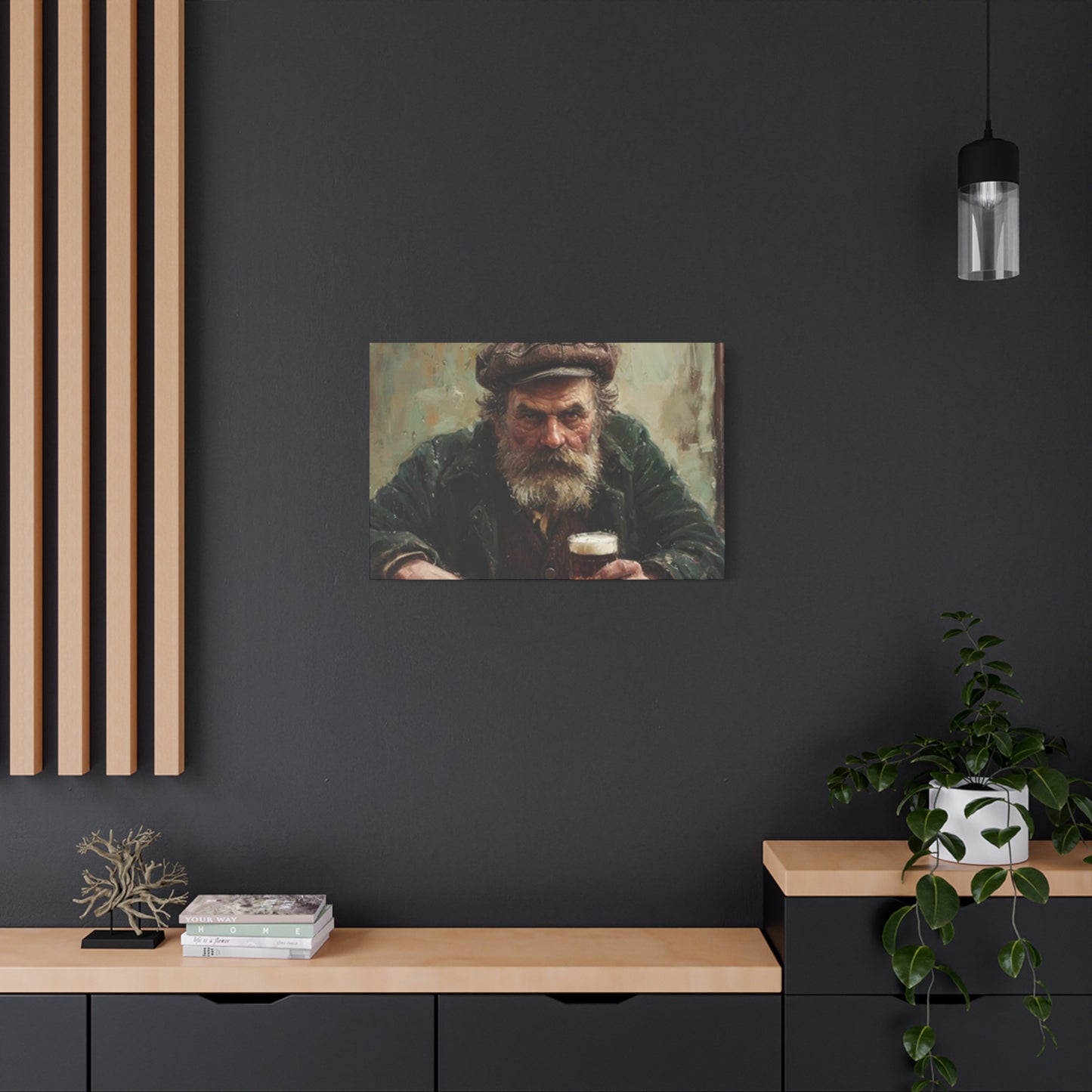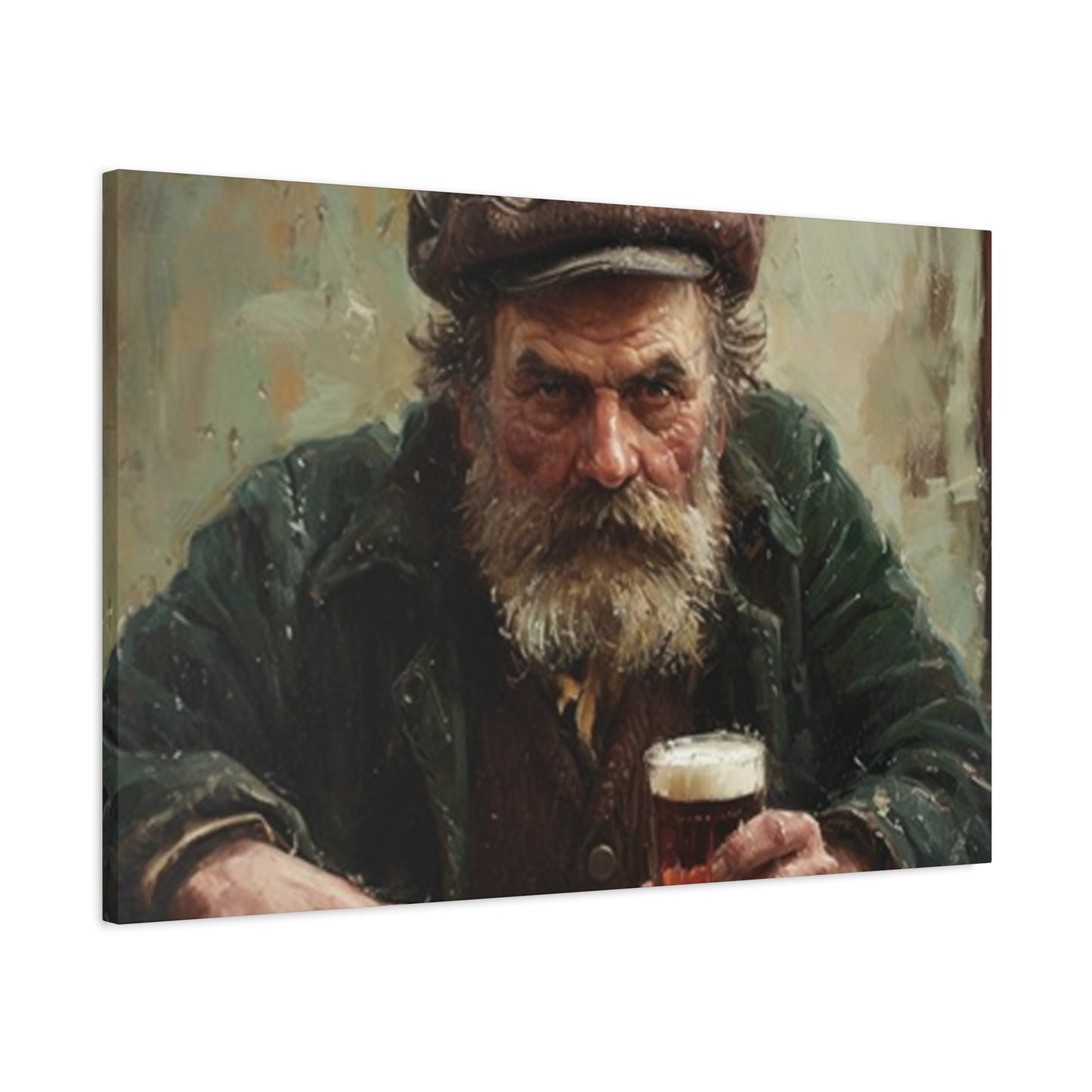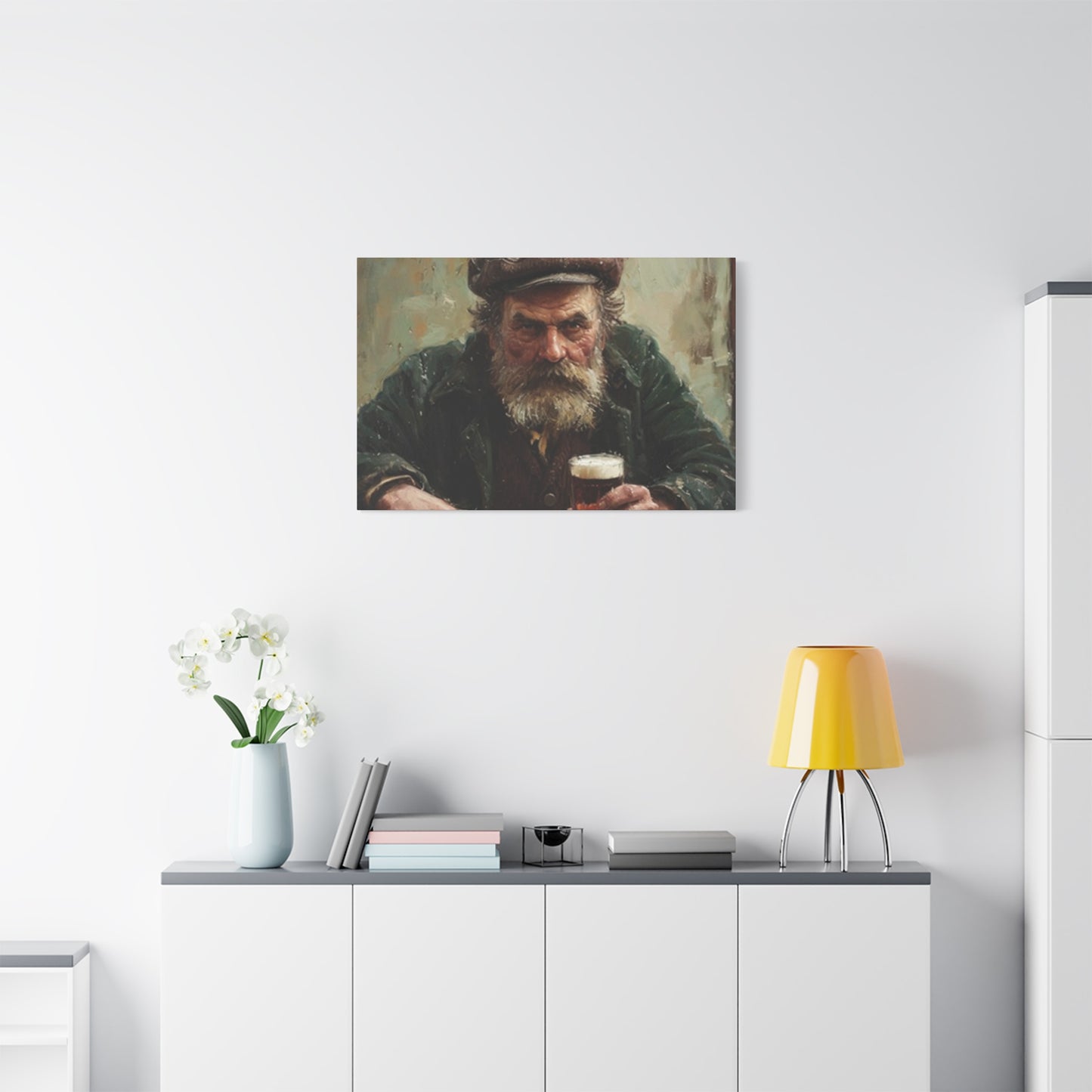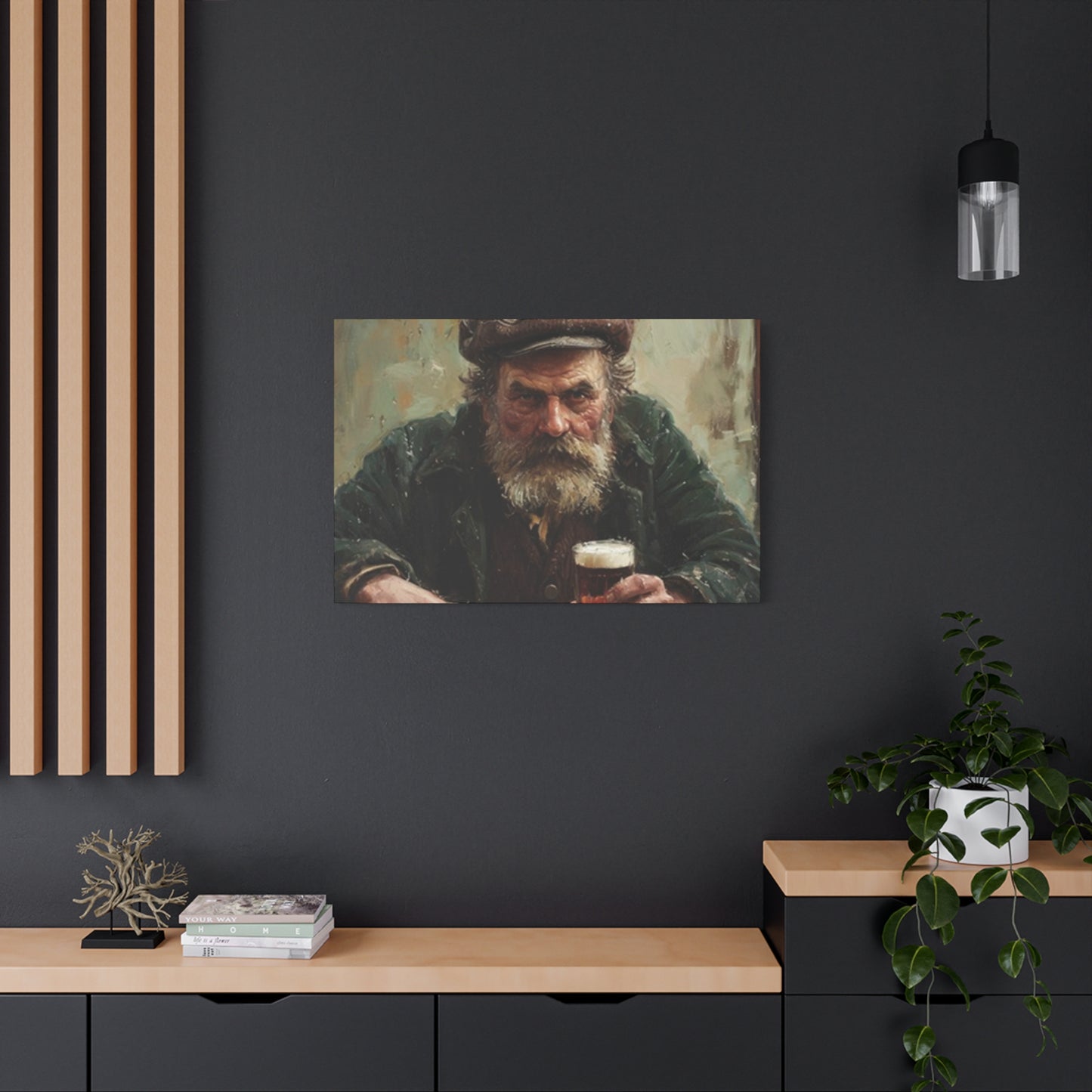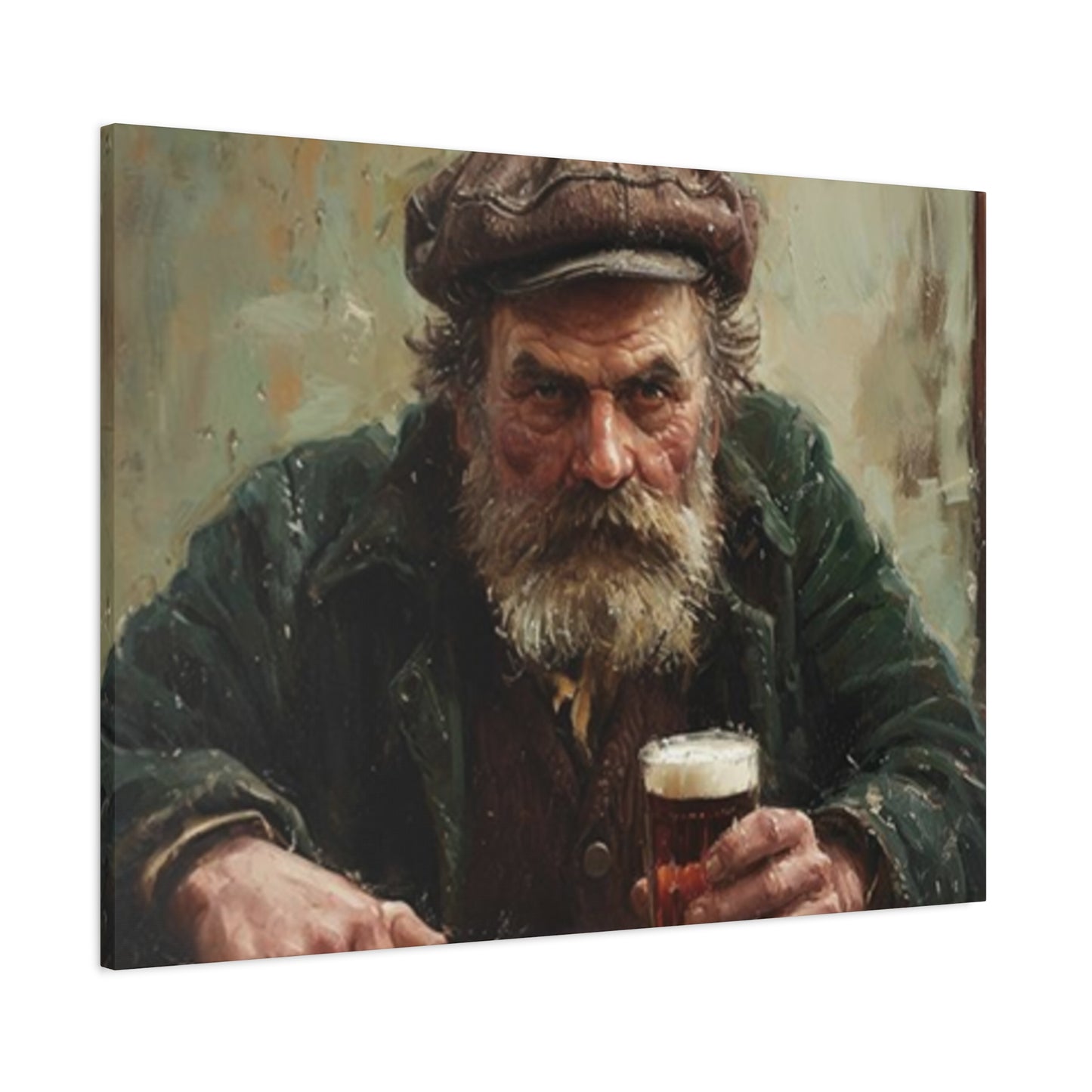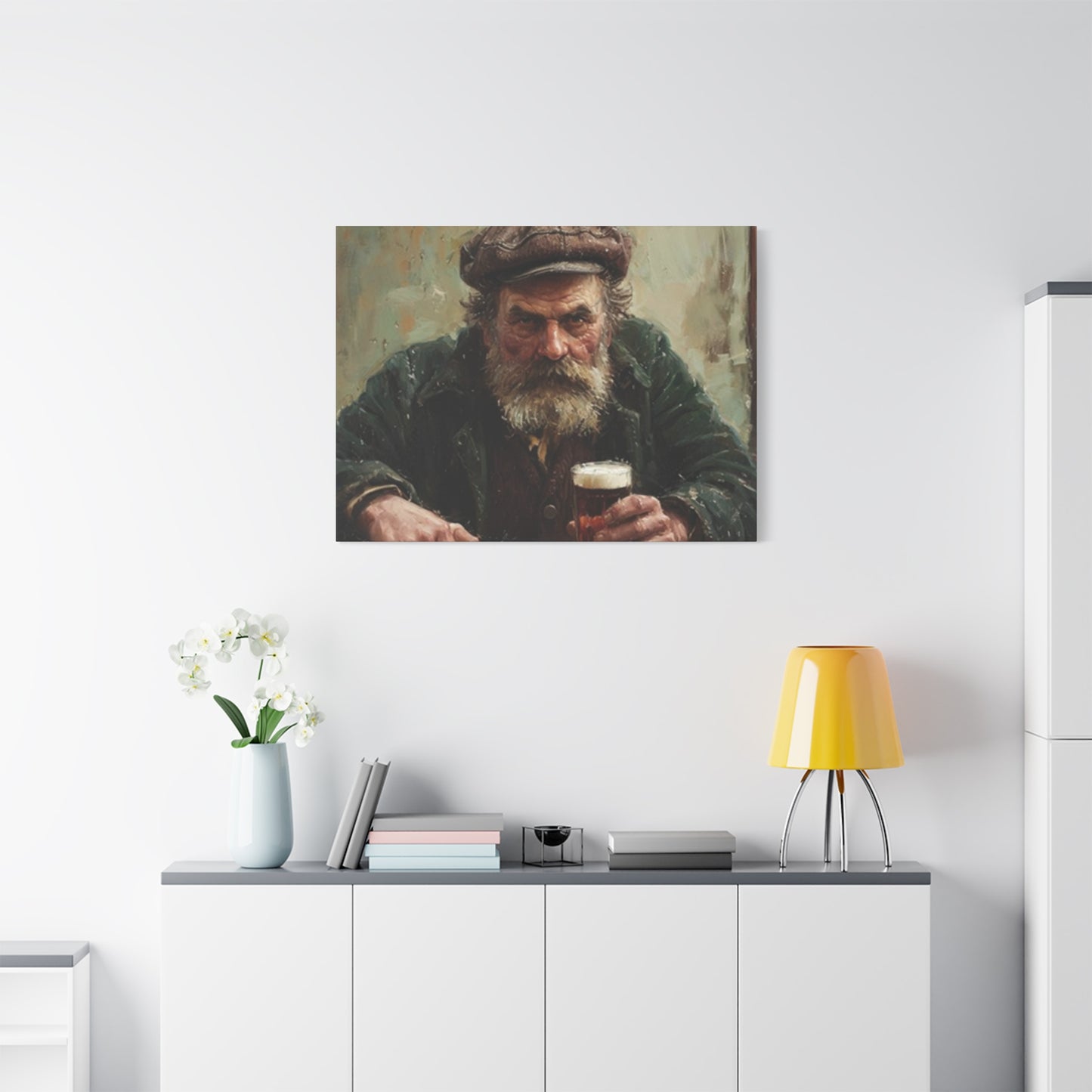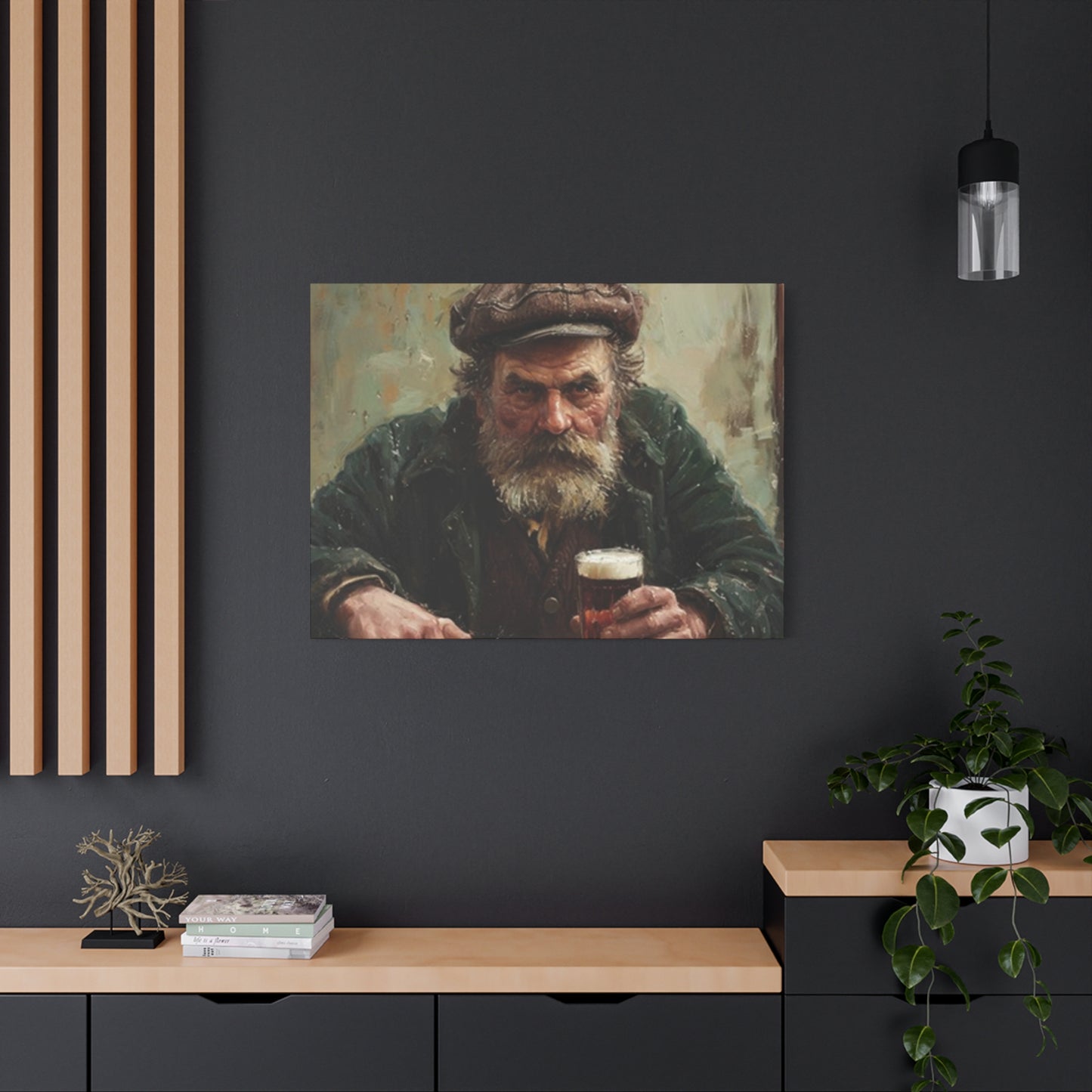The Art of Relaxation: Exploring Themes in “Old Man with a Beer” Paintings Wall art
When it comes to decorating your home or commercial space, finding artwork that perfectly captures a mood, tells a story, and adds character can be challenging. Among the many themes available in contemporary wall art, imagery featuring a man enjoying a cold beer has emerged as a surprisingly versatile and popular choice. This style of artwork combines relaxation, camaraderie, and everyday joy into visual narratives that resonate with people from all walks of life. Whether you're furnishing a private home lounge, designing a neighborhood tavern, or simply looking for art that reflects life's simple pleasures, this genre offers endless possibilities.
The appeal of such artwork lies in its ability to capture authentic moments of leisure. These pieces don't try to be overly sophisticated or pretentious. Instead, they celebrate the ordinary in extraordinary ways, reminding us that happiness often exists in uncomplicated moments. A man raising a glass, savoring a drink after a long day, or sharing laughs with friends becomes more than just a scene; it transforms into a symbol of human connection, rest, and celebration.
This comprehensive exploration will delve into every aspect of this artistic genre, from its cultural significance to practical decorating tips, helping you understand why these pieces have become sought-after additions to modern interior design. We'll examine the various styles available, discuss the psychological impact of such imagery, and provide detailed guidance on selecting, displaying, and caring for these unique artworks.
Comfortable Atmosphere Through Visual Storytelling
Creating an inviting atmosphere in any space requires careful consideration of multiple elements, and wall art plays a crucial role in setting the tone. Artwork depicting a man with a beer offers a unique advantage in establishing a relaxed, welcoming environment. These pieces communicate informality and comfort without sacrificing style or sophistication.
The power of visual storytelling in interior design cannot be overstated. When guests enter a room adorned with such artwork, they immediately understand the space's purpose and personality. The imagery sends a clear message about the values celebrated within those walls: friendship, leisure, authenticity, and appreciation for life's everyday pleasures. This makes these pieces particularly effective in social spaces where you want people to feel immediately at ease.
Beyond mere decoration, these artworks serve as conversation starters. Guests naturally gravitate toward pieces that depict relatable scenarios, and a well-chosen canvas showing someone enjoying a drink provides endless opportunities for storytelling and connection. People share their own experiences, favorite beverages, memorable nights out, and the artwork becomes a catalyst for building relationships and creating new memories.
The casual nature of the subject matter also helps balance more formal elements in a room. If your space features traditional furniture, structured layouts, or professional necessities like office equipment, adding artwork that depicts relaxed moments creates important visual counterbalance. This juxtaposition prevents spaces from feeling too rigid or uninviting, adding human warmth to potentially sterile environments.
Furthermore, these pieces work exceptionally well in spaces where people gather to unwind. Game rooms, personal libraries, basement lounges, and even outdoor covered patios benefit from artwork that reinforces their purpose as retreat spaces. The visual reminder to slow down and enjoy the moment aligns perfectly with the function of these areas, creating cohesive design that feels intentional and thoughtful.
Everyday Celebrations Immortalized on Canvas
There's something profoundly democratic about artwork that celebrates ordinary experiences. While many traditional art forms focus on grand historical events, mythological scenes, or abstract concepts, pieces showing a man with a beer ground themselves in the everyday. This accessibility makes them appealing to a broad audience and allows viewers to see themselves reflected in the artwork.
Canvas prints featuring these scenes capture fleeting moments that might otherwise go unnoticed. The gesture of raising a glass, the condensation on a cold bottle, the satisfied expression after the first sip—these details collectively tell stories about human experience that transcend cultural and economic boundaries. People worldwide recognize and relate to the simple pleasure of enjoying a favorite beverage.
The artistic treatment of these common moments elevates them from mundane to meaningful. Skilled artists use lighting, composition, color theory, and technique to transform a basic scene into something worth contemplating. A well-executed piece might use dramatic shadows to create mood, employ vibrant colors to convey energy and celebration, or utilize softer tones to suggest quiet contentment. These artistic choices transform simple subject matter into sophisticated visual commentary on the nature of happiness and relaxation.
Many contemporary artists working in this genre draw inspiration from various historical art movements. Some pieces echo the warm, earthy tones of Dutch Golden Age tavern scenes, while others incorporate the bold lines and simplified forms of modern graphic design. This fusion of classical influence and contemporary sensibility results in artwork that feels both timeless and current, capable of complementing diverse decorating styles.
The celebration of everyday moments also serves an important psychological function. In our increasingly fast-paced world, where productivity and achievement often receive disproportionate emphasis, artwork that honors rest and pleasure provides necessary balance. These pieces remind viewers that taking time to relax isn't indulgent or wasteful but essential for wellbeing. They give visual permission to pause, reflect, and enjoy without guilt or urgency.
Bringing Tavern Character to Personal Spaces
The aesthetic associated with traditional taverns, pubs, and bars carries a unique appeal that many people want to incorporate into their homes. These establishments have historically served as community gathering places, offering not just refreshments but also companionship, entertainment, and respite from daily concerns. Artwork featuring a man with a beer helps channel this distinctive atmosphere into personal spaces.
Authentic tavern character encompasses several elements: warm lighting, natural materials like wood and leather, comfortable seating, and visual interest through artwork and memorabilia. Wall art depicting drinking scenes contributes significantly to this ambiance, adding layers of narrative and visual texture that printed beer logos or generic decorations cannot match. These pieces suggest history, tradition, and human connection in ways that feel organic rather than manufactured.
When incorporating this aesthetic into home design, balance is essential. You want to capture the welcoming warmth of a favorite pub without making your living space feel like a commercial establishment. Carefully selected artwork bridges this gap beautifully. A single large canvas or a curated collection of smaller pieces can establish the desired mood without overwhelming the space with bar-related imagery.
The beauty of this approach lies in its flexibility. A man with a beer canvas fits naturally in obvious locations like home bars and entertainment rooms, but it also works surprisingly well in unexpected places. A sophisticated piece in muted tones might complement a dining room, subtly suggesting the convivial meals shared there. A vintage-style print could add character to a kitchen, acknowledging it as the heart of home hospitality. Even bedrooms and private studies can benefit from carefully chosen pieces that promote relaxation.
Different artistic styles within this genre support various aspects of tavern character. Vintage-inspired pieces with aged effects and classic typography evoke historic pubs and traditional brewing culture. Photo-realistic paintings capture the gleaming surfaces and ambient lighting of modern craft beer bars. Stylized illustrations with bold colors and simplified forms channel the energy of lively social spaces. Each approach offers distinct advantages depending on your desired atmosphere.
The social history embedded in tavern culture also adds depth to these artistic choices. Throughout history, such establishments have served as meeting places for revolutionaries plotting change, artists sharing ideas, workers finding community after long shifts, and friends maintaining connections across decades. Artwork that references this tradition connects your personal space to this rich social tapestry, suggesting your home as a place where similar meaningful interactions occur.
Visual Representations of Friendship and Connection
At their core, most pieces showing a man with a beer aren't really about the beverage itself but about the human experiences surrounding it. These artworks frequently capture moments of connection, celebration, and camaraderie that happen to include a drink. This focus on relationships and shared experience gives these pieces emotional resonance that purely decorative art often lacks.
The social ritual of sharing drinks has existed across cultures and throughout history. Breaking bread and raising glasses together symbolizes trust, equality, and mutual regard. Artwork depicting these moments taps into this universal symbolism, communicating values of friendship and community without words. When you display such art in your home, you're making a statement about what matters to you beyond material success or individual achievement.
Many pieces in this genre feature multiple figures interacting, telling stories about friendship through body language, facial expressions, and composition. Others show a solitary figure in a moment of contentment, inviting viewers to imagine the conversations and connections that preceded and will follow that quiet pause. Both approaches celebrate the social aspects of drinking culture, acknowledging that even moments of solitude are sweeter when we have people to share life with.
The psychology of these images is worth considering. Humans are inherently social creatures, and we respond positively to visual representations of positive social interaction. Artwork showing people enjoying themselves together activates mirror neurons and empathy responses, making viewers feel more connected and relaxed. This makes such pieces particularly valuable in spaces designed for entertaining, as they prime guests for positive social experiences before conversations even begin.
Furthermore, these artworks can serve as visual anchors for your own memories and relationships. A canvas depicting friends sharing drinks might remind you of your own closest friendships, the inside jokes, the support through difficult times, and the celebrations of victories large and small. In this way, the artwork becomes personally meaningful beyond its aesthetic qualities, serving as a daily reminder of what enriches your life.
The theme of connection extends beyond immediate friendships to broader community and cultural identity. For many people, certain beverages connect them to cultural heritage, family traditions, or geographic roots. A piece showing someone enjoying a specific type of beer might evoke memories of places visited, cultural experiences, or family gatherings. This layered meaning transforms simple wall art into something far more significant and personal.
Artistic Interpretations of Leisure and Relaxation
The concept of leisure has evolved significantly over time, but the fundamental human need for rest and recreation remains constant. Artwork depicting a man with a beer offers visual meditation on the value of downtime, presenting relaxation not as laziness but as necessary restoration. These pieces challenge the constant productivity demands of modern life, suggesting an alternative set of priorities.
Different artistic styles approach this theme in various ways. Impressionistic pieces might use soft brushstrokes and muted colors to create dreamlike qualities that mirror the mental shift that occurs when we truly relax. The blurred boundaries and gentle transitions between elements suggest the softening of rigid structures and the flow state that characterizes genuine leisure. These pieces work particularly well in spaces dedicated to quiet relaxation like reading nooks or meditation areas.
In contrast, more vibrant and energetic interpretations celebrate the invigorating aspects of social relaxation. Bold colors, dynamic compositions, and expressive techniques convey the revitalizing energy of time spent with friends or enjoying favorite activities. These pieces remind us that relaxation isn't always quiet or passive but can involve laughter, conversation, and animated engagement. Such artwork suits social spaces where energy and interaction are encouraged.
Realistic portrayals offer yet another perspective, capturing specific moments with photographic precision. The detail in these pieces allows viewers to notice small elements: the texture of fabric, the play of light on glass surfaces, the subtle expressions that reveal inner states. This attention to detail encourages mindful observation, slowing viewers down and drawing them into the moment depicted. The artwork thus becomes a tool for practicing presence and appreciation.
The subject's demeanor and setting significantly influence the piece's overall message about leisure. A figure alone in contemplation suggests introspection and peaceful solitude. Someone laughing with companions emphasizes the social dimensions of relaxation. A character in casual clothing in a comfortable setting normalizes and validates taking time away from formal obligations. Each variation offers different but equally valuable perspectives on what it means to truly rest.
Contemporary discussions about work-life balance and burnout prevention make these artistic themes particularly relevant. Displaying artwork that explicitly values leisure and pleasure makes a statement about priorities, both to yourself and to others who enter your space. It serves as a visual reminder that life consists of more than obligations and productivity, that joy and connection deserve time and attention.
Selection Strategies for Different Environments
Choosing the right artwork for a specific space involves considering multiple factors: the room's purpose, existing decor, lighting conditions, and the emotional atmosphere you want to create. Artwork showing a man with a beer comes in such diverse styles that finding appropriate pieces for virtually any environment is possible, but success requires thoughtful selection.
For home entertainment areas and personal lounges, you have considerable freedom to embrace more casual or playful interpretations. These spaces explicitly exist for relaxation and socializing, so artwork that reinforces these functions through humor, vibrant energy, or obvious leisure themes works perfectly. Larger pieces or gallery wall arrangements make strong visual statements in these rooms, serving as focal points around which furniture and activities naturally organize.
Dining spaces benefit from pieces that emphasize the social and celebratory aspects of sharing drinks. Look for artwork depicting multiple figures in conversation, toasting, or gathered around a table. The composition should feel inclusive and warm, encouraging the kind of lingering, comfortable meals where guests lose track of time. Color palettes that complement your dining area while adding visual interest without overwhelming the space work best.
For commercial establishments like restaurants, taverns, and hospitality venues, authenticity and quality become crucial. Customers increasingly appreciate thoughtful design, and generic or obviously mass-produced artwork can undermine the atmosphere you're trying to create. Invest in pieces with artistic merit that align with your establishment's identity. A craft beer bar might feature contemporary interpretations with modern aesthetics, while a traditional pub could showcase vintage-inspired pieces that suggest history and heritage.
Home offices and personal workspaces present interesting opportunities for these artworks. While it might seem counterintuitive to feature leisure imagery in a productivity-focused environment, strategically placed pieces can actually enhance work quality. A small canvas visible from your desk serves as a visual reminder to take breaks, maintain perspective, and remember that work exists to support life rather than consuming it. Choose pieces with calmer energy and sophisticated execution to maintain professional atmosphere.
Kitchens increasingly serve as social hubs rather than purely functional spaces, making them suitable for carefully selected beer-related artwork. Pieces that incorporate food elements or suggest hospitality and gathering work particularly well. The style should complement your kitchen's aesthetic, whether that's rustic farmhouse, sleek modern, or eclectic vintage. Smaller pieces or a series of related images often work better than single large canvases in kitchens due to space constraints and visual competition from cabinetry and appliances.
Even bedrooms can accommodate these artworks when chosen thoughtfully. For this intimate space, select pieces with softer energy, perhaps showing a solitary figure in quiet contentment rather than lively social scenes. The artwork should promote relaxation and peace rather than stimulation. Muted color palettes and smaller scales typically work better in bedrooms, contributing to tranquility rather than demanding attention.
Color Psychology and Mood Creation
Color significantly impacts how we perceive and respond to visual art, making color selection crucial when choosing pieces for specific spaces and purposes. Artwork featuring a man with a beer comes in virtually every color palette imaginable, from warm earth tones to cool blues, vibrant primaries to subtle neutrals. Understanding color psychology helps you select pieces that create your desired emotional atmosphere.
Warm colors like reds, oranges, and yellows evoke energy, warmth, and sociability. Pieces dominated by these hues feel inviting and stimulating, perfect for social spaces where you want to encourage conversation and interaction. The golden tones of beer itself often feature prominently in these works, catching light and adding visual richness. Warm palettes also create cozy feelings, making spaces feel more intimate and comfortable even when physically large.
Cool colors including blues, greens, and purples suggest calm, sophistication, and contemplation. Artwork emphasizing these tones works well in spaces designed for relaxation rather than high-energy socializing. A piece featuring a man with a beer rendered primarily in cool tones might emphasize the peaceful, restorative aspects of taking time to unwind. These colors also tend to recede visually, making them good choices for smaller spaces where you don't want artwork to overwhelm.
Neutral palettes featuring blacks, whites, grays, and browns offer versatility and timeless appeal. These pieces integrate easily with diverse decorating styles and color schemes, making them practical choices for spaces you might redecorate periodically. The neutral background allows other elements like composition, lighting, and subject matter to take prominence. Many sophisticated interpretations of beer-related imagery use primarily neutral palettes with small pops of color for visual interest.
Contrasting colors create visual drama and capture attention. A piece that juxtaposes complementary colors like blue and orange or purple and yellow demands notice and energizes spaces. This approach works well when you want artwork to serve as a focal point or conversation starter. However, high-contrast pieces require careful integration with surrounding decor to avoid visual chaos.
The intensity or saturation of colors also affects mood. Highly saturated, vibrant colors feel energetic and modern, often associated with contemporary design aesthetics. Desaturated or muted colors suggest vintage quality, sophistication, or tranquility. Many beer-related artworks intentionally use aged or faded color palettes to evoke nostalgia and tradition, connecting contemporary spaces with brewing and drinking culture history.
Lighting conditions in your space significantly affect how colors appear. Natural light changes throughout the day, altering artwork appearance. Artificial lighting varies in color temperature, from warm incandescent to cool LED. When possible, view potential art purchases in lighting similar to where you'll display them, or at least consider how your space's lighting will interact with the piece's colors.
Style Variations and Artistic Approaches
The diversity of artistic styles available within this genre ensures that people with vastly different aesthetic preferences can find suitable pieces. From hyperrealistic paintings to abstract interpretations, vintage-inspired designs to contemporary minimalism, the range accommodates every decorating sensibility and personal taste.
Realistic or photorealistic approaches capture scenes with exacting detail, often resembling high-quality photographs. These pieces showcase technical skill and allow viewers to appreciate subtle elements like texture, lighting, and expression. Realistic artwork featuring a man with a beer might emphasize the condensation on a cold glass, the foam head on a freshly poured pint, or the complex interplay of light and shadow in a tavern setting. These pieces appeal to those who appreciate technical mastery and want artwork that feels immediate and accessible.
Impressionistic styles prioritize mood and atmosphere over precise detail. Loose brushwork, visible texture, and emphasis on light effects characterize this approach. An impressionistic piece depicting someone enjoying a drink might capture the warm glow of ambient lighting, the general sense of relaxation and contentment, without defining every element sharply. These works feel more interpretive and emotional, leaving space for viewer imagination while conveying clear feelings and impressions.
Expressionistic and abstract approaches push further from literal representation, using color, form, and composition to convey emotional or conceptual content. These pieces might use exaggerated proportions, unexpected color choices, or simplified forms to communicate ideas about celebration, relaxation, or social connection. While more challenging to integrate into some decorating schemes, these works offer intellectual interest and artistic sophistication that realistic pieces might lack.
Vintage and retro styles deliberately evoke earlier design eras, often incorporating aged effects, classic typography, and period-appropriate color palettes. These pieces connect contemporary spaces with brewing tradition and drinking culture history. They're particularly popular in establishments wanting to suggest heritage and authenticity. The vintage aesthetic works equally well in homes, adding character and visual interest while suggesting timelessness.
Contemporary or modern approaches emphasize clean lines, simplified forms, and current design sensibilities. These pieces might use geometric elements, limited color palettes, or graphic design techniques to create striking images that feel current and sophisticated. Modern interpretations of beer-related imagery often focus on shape, pattern, and composition rather than narrative detail, resulting in artwork that functions as both representation and abstract design element.
Mixed media and collage techniques combine various materials and methods to create textured, layered works. These pieces might incorporate actual beer labels, vintage advertisements, typography, painting, and digital elements. The resulting complexity adds visual interest and often allows for clever commentary on drinking culture, commercialism, or social rituals. Mixed media works particularly well in eclectic or artistic spaces that celebrate creativity and unconventional approaches.
Pop art influences appear in many contemporary pieces, using bold colors, repeated imagery, and commercial art techniques to create eye-catching works. This style playfully references consumerism and popular culture while creating visually striking pieces. Pop art interpretations of beer imagery often feel energetic and youthful, suitable for modern spaces that embrace bold design choices.
Cultural Significance and Social Commentary
Artwork depicting drinking scenes carries layers of cultural meaning beyond simple decoration. Throughout art history, images of people consuming alcohol have served various purposes: celebrating social bonds, commenting on class and status, critiquing excess, or simply documenting everyday life. Contemporary pieces showing a man with a beer continue this tradition, sometimes offering subtle social commentary alongside aesthetic appeal.
The democratization of leisure represents one theme running through much of this work. Historically, extensive leisure time was a privilege of the wealthy, while working people had limited opportunity for relaxation. Modern images of ordinary people enjoying drinks celebrate the hard-won right to rest, reasonable working hours, and time for pleasure regardless of economic status. This democratic spirit makes such artwork feel inclusive and accessible rather than elitist.
Craft beer culture, which has exploded globally in recent decades, influences much contemporary artwork in this genre. The movement emphasizes quality, tradition, local production, and appreciation of craft and expertise. Art reflecting these values often features more sophisticated aesthetics, emphasizing the beverage as something worthy of attention and appreciation rather than mere commodity. These pieces appeal particularly to audiences who value artisanal production and conscious consumption.
Some artwork in this category offers gentle critique of drinking culture, highlighting excess or the sometimes complicated relationship societies have with alcohol. Pieces might use irony, exaggeration, or juxtaposition to comment on advertising messages, social pressure, or the role alcohol plays in social interaction. While still visually appealing, these works engage viewers on intellectual levels, prompting reflection alongside appreciation.
Cultural and regional identity frequently appears in beer-related artwork. Different cultures have distinct drinking traditions, vessel styles, and social rituals around alcohol consumption. Art that references these specifics can evoke place and heritage. A piece depicting someone enjoying a particular regional beer style or using traditional drinkware connects viewers to specific cultural contexts, whether celebrating their own heritage or exploring others.
Gender dynamics deserve consideration within this genre. Historically, drinking establishments and culture were often male-dominated spaces, and much traditional imagery reflects this. Contemporary artists increasingly create more inclusive representations, showing diverse figures enjoying drinks. When selecting artwork, consider what messages different representations send about who belongs in social and leisure spaces.
The evolution of public attitudes toward alcohol consumption also contextualizes this artwork. Societies navigate complex relationships with alcohol, balancing appreciation of cultural traditions and social benefits against concerns about health, addiction, and social problems. Quality artwork in this genre often acknowledges this complexity, celebrating positive aspects while remaining thoughtful about broader implications.
Integration with Interior Design Trends
Successfully incorporating artwork featuring a man with a beer requires understanding current interior design trends and how such pieces complement or challenge them. Fortunately, the diversity of styles available makes integration possible across virtually all contemporary design approaches.
Industrial design, characterized by exposed brick, metal fixtures, concrete elements, and utilitarian aesthetics, pairs naturally with beer-related artwork. The connection to warehouse-style breweries and urban taprooms makes this combination feel organic. Choose pieces with edgier aesthetics, perhaps featuring dramatic lighting, gritty textures, or urban settings. Monochromatic or limited color palettes often work well with industrial spaces, allowing artwork to complement rather than compete with architectural elements.
Farmhouse and rustic styles emphasize natural materials, vintage elements, and comfortable informality. Beer imagery fits beautifully into these schemes, particularly pieces with vintage aesthetics or those emphasizing craft and tradition. Warm wood tones in frames complement rustic interiors, while artwork colors should harmonize with the earthy palettes typical of farmhouse design. These spaces often feature collections of related items, so grouping several complementary pieces creates cohesive gallery walls.
Modern and contemporary design prioritizes clean lines, minimal clutter, and intentional choices about what to include. In these spaces, fewer, more carefully selected pieces work better than cluttered collections. Choose artwork with sophisticated execution and contemporary aesthetics. The subject matter provides casual warmth that prevents modern spaces from feeling cold or sterile, while strong composition and quality execution maintain the design sophistication these styles require.
Eclectic and bohemian interiors celebrate mixing styles, eras, and influences into cohesive wholes through color coordination and balanced distribution of visual weight. These forgiving styles accommodate diverse artwork, including beer-related pieces. The key is ensuring your selections dialogue with other elements rather than feeling randomly placed. Repetition of colors, themes, or styles across different items creates unity within diversity.
Scandinavian design emphasizes simplicity, functionality, and connection to nature, typically featuring neutral colors with occasional pops of color. Beer artwork in these spaces should maintain relatively simple compositions and not overwhelm with excessive detail or intense colors. Pieces emphasizing natural materials like wood serving boards or ceramic vessels align with Scandinavian values. The artwork should feel peaceful and uncomplicated while adding necessary personality and warmth.
Maximalist design embraces abundance, pattern, and visual complexity. In these spaces, beer-related artwork contributes to the overall richness rather than standing alone. Choose pieces with strong visual presence that hold their own among other bold elements. Ornate frames, vibrant colors, and complex compositions work well in maximalist settings. Consider how artwork layers with wallpaper, textiles, and collectibles to create satisfying visual density.
Transitional design bridges traditional and contemporary elements, creating spaces that feel current but timeless. Beer artwork for transitional spaces should similarly balance classic and modern qualities. Perhaps a traditional tavern scene rendered with contemporary color palettes, or modern graphic approaches to vintage subject matter. These pieces help unify the traditional and contemporary elements present in transitional design.
Sizing and Placement Considerations
Proper sizing and placement dramatically affect artwork's impact and how it integrates with its environment. Even excellent pieces can fail to achieve their potential if poorly positioned or incorrectly sized for their spaces. Understanding basic principles helps you make decisions that maximize your artwork's effectiveness.
Scale relationship between artwork and wall space follows general guidelines while allowing flexibility based on specific situations. For walls with minimal furniture, a single large piece typically should cover between half and three-quarters of the available width. Too small creates a disconnected floating feeling, while too large overwhelms and can make walls feel cramped. Multiple smaller pieces arranged gallery-style can fill similar proportions while offering more visual variety.
Above furniture requires different calculations. Artwork should relate visually to the furniture below it, typically spanning about two-thirds to three-quarters of the furniture width. For pieces hung above sofas, bars, or consoles, this proportion creates visual connection and balance. Hanging height also matters; the artwork center should generally sit at eye level, typically between 57 and 60 inches from the floor, though this adjusts when hanging above furniture.
Gallery wall arrangements offer flexibility but require planning for successful execution. Before hammering any nails, arrange pieces on the floor in your intended configuration, photographing from above. This allows experimentation without wall damage. Maintain relatively consistent spacing between pieces, typically 2 to 4 inches, for cohesive appearance. Mixing sizes adds interest, but ensure the overall arrangement forms a pleasing shape, whether geometric or organic.
Focal point creation guides placement decisions. In rooms lacking architectural focal points like fireplaces or dramatic windows, artwork can serve this purpose. Position significant pieces where they naturally draw the eye when entering the room. In spaces with existing focal points, artwork should complement rather than compete, positioned to enhance the overall composition.
Lighting significantly affects how artwork appears and how much attention it receives. Natural light provides beautiful illumination but causes fading over time; avoid placing valuable pieces in direct sunlight. Artificial lighting options include track lighting, picture lights, and strategically placed lamps. Proper lighting not only protects artwork but also ensures it receives attention appropriate to its importance in your design scheme.
Room function influences ideal placement. In conversation areas, position artwork where people naturally look when seated, creating comfortable viewing angles. In dining spaces, pieces should be visible from the table without requiring uncomfortable head positioning. In entertainment areas, ensure artwork doesn't compete with screens or gaming equipment for attention. Thoughtful placement respects both the artwork and the space's primary purpose.
Balance and symmetry considerations affect overall room composition. Symmetrical arrangements with matching pieces on either side of a center point feel formal and orderly. Asymmetrical arrangements require more careful calibration but feel more dynamic and contemporary. When arranging asymmetrically, balance visual weight rather than creating mirror images. A larger piece on one side might balance several smaller pieces on the other.
Materials and Production Methods
The physical materials and production methods used to create beer-related artwork significantly affect its appearance, durability, and suitability for different environments. Understanding these factors helps you make informed purchasing decisions and properly care for your pieces.
Canvas prints have become increasingly popular for both original paintings and reproductions. The textile surface provides texture and depth that flat prints lack, while remaining more affordable than original paintings. Quality canvas prints use fade-resistant inks on archival-quality fabric, ensuring longevity. Stretched canvas pieces arrive ready to hang, while rolled canvases require professional stretching and mounting. The texture of canvas particularly suits impressionistic and painterly styles, enhancing their visual impact.
Paper prints, including posters and fine art prints, offer the most affordable option. Quality varies enormously, from cheap posters that fade quickly to museum-quality giclée prints on archival paper. When selecting paper prints, inquire about ink and paper quality. Acid-free paper and UV-resistant inks ensure your investment maintains its appearance. Paper prints require framing with glass or acrylic glazing for protection, adding to the overall cost and weight.
Metal prints create contemporary, high-impact pieces through dye-sublimation printing directly onto aluminum panels. The result is incredibly vibrant colors, sharp details, and a unique luminous quality. Metal prints resist fading, moisture, and scratching better than most alternatives, making them ideal for challenging environments like kitchens or commercial spaces. The modern aesthetic suits contemporary interiors particularly well, though the price point exceeds many other options.
Acrylic or plexiglass prints sandwich images between clear acrylic layers or print directly onto acrylic surfaces, creating depth and vibrancy that's almost three-dimensional. These pieces feel modern and sophisticated, with colors that seem to glow. Acrylic is durable and easy to clean, though it can scratch. The contemporary appearance works best in modern or transitional design schemes.
Wood prints transfer images onto wood surfaces, creating rustic, organic pieces perfect for farmhouse or industrial aesthetics. The wood grain shows through, adding texture and natural variation. These pieces feel casual and warm, complementing informal spaces beautifully. Durability is good, though wood responds to humidity changes and isn't ideal for bathrooms or outdoor spaces.
Framing choices dramatically affect final appearance. Traditional wood frames suit vintage or classic pieces, available in countless profiles and finishes. Metal frames feel more contemporary and industrial. Floating frames create modern presentations where artwork appears suspended within the frame. No-frame options, including gallery wraps where canvas extends around frame edges, suit contemporary minimalist aesthetics. Mat boards add sophistication and protect artwork, available in numerous colors to complement or contrast with the piece.
Original artwork, whether paintings or mixed media pieces, represents the premium option. These one-of-a-kind works carry intrinsic value beyond their decorative function. Original pieces require more substantial investments but offer incomparable authenticity and artistic merit. They also appreciate in value if the artist gains recognition. When purchasing original artwork, establish authenticity through certificates or artist signatures.
Limited edition prints occupy middle ground between open edition prints and originals. Artists produce limited quantities, often signing and numbering each print. This scarcity creates value while remaining more accessible than original artwork. Limited editions suit collectors and those wanting something special without original artwork prices. Verify edition size and obtain certificates of authenticity when purchasing limited editions.
Care and Preservation Techniques
Proper care extends artwork lifespan and maintains its appearance, protecting your investment and ensuring continued enjoyment. Different materials require specific maintenance approaches, but general principles apply across categories.
Environmental control prevents most artwork damage. Excessive humidity promotes mold growth and warping, while extreme dryness causes cracking and brittleness. Maintain relative humidity between 40 and 60 percent for optimal preservation. Temperature fluctuations stress materials; keep artwork in climate-controlled spaces away from heating vents, air conditioners, and fireplaces. Direct sunlight fades colors and degrades materials; position pieces away from windows or use UV-filtering glass in frames.
Cleaning requires gentle approaches specific to materials. Canvas pieces benefit from light dusting with soft, dry brushes or microfiber cloths. Avoid liquid cleaners unless specifically designed for art. For stubborn dirt, consult professional conservators rather than risking damage. Framed pieces behind glass require cleaning of the glass only, using gentle glass cleaners and soft cloths. Never spray cleaner directly onto frames or glass; apply to cloth first to prevent liquid seeping behind glass.
Metal prints clean easily with damp microfiber cloths and mild soap if needed. Avoid abrasive cleaners or scrubbing that could scratch surfaces. Acrylic pieces require special care as they scratch more easily than glass. Use cleaners specifically designed for acrylic, applying with soft cloths in gentle circular motions. For wood prints, dust regularly with dry cloths and occasionally treat with appropriate wood care products to maintain finish.
Storage of unframed or temporarily removed artwork requires protection from dust, moisture, and physical damage. Wrap pieces in acid-free tissue or glassine paper, never plastic bags which trap moisture. Store flat if possible, or rolled with the image facing outward around large diameter tubes if necessary. Keep stored artwork in climate-controlled spaces, avoiding attics, basements, or garages where temperature and humidity fluctuate dramatically.
Regular inspection catches problems early. Examine artwork periodically for signs of fading, yellowing, insect damage, mold growth, or structural issues like loose frames or warping. Address problems promptly; minor issues often become major damage if ignored. For valuable pieces or significant damage, consult professional conservators rather than attempting repairs yourself.
Rotation prevents uneven fading and gives you variety in displayed pieces. If you have multiple artworks, rotate what's displayed every few months or seasonally. This practice particularly benefits pieces in bright locations, giving them periodic rest from light exposure. Rotation also keeps your space feeling fresh and allows you to appreciate pieces anew after time in storage.
Insurance considerations become important for valuable artwork. Document your pieces with photographs and receipts, noting dimensions, artists, and purchase details. Some insurance policies exclude or limit coverage for art; consider riders or specialized art insurance for valuable collections. Keep documentation in secure locations separate from the artwork itself.
Professional conservation services offer solutions for damaged or deteriorating pieces. Conservators can repair tears, address fading, clean away years of grime, and restore frames. While expensive, professional conservation preserves valuable pieces and family heirlooms. For pieces with sentimental rather than monetary value, weigh conservation costs against replacement options.
Finding and Selecting Quality Pieces
The marketplace for beer-related wall art includes everything from mass-produced prints to unique original works, available through various channels at vastly different price points. Navigating these options successfully requires understanding where to look, what questions to ask, and how to evaluate quality.
Online marketplaces offer enormous selection and convenience. Major platforms feature thousands of options from sellers worldwide, allowing easy comparison shopping. However, quality varies dramatically, and photographs don't always accurately represent actual pieces. Read seller reviews, examine return policies, and scrutinize product descriptions for materials and production methods. Be wary of prices that seem too good to be true; they usually indicate inferior materials or unethical production practices.
Artist websites and online galleries provide direct access to creators, often offering original works, limited editions, and high-quality prints. Purchasing directly from artists ensures authenticity while supporting creative livelihoods. Many artists accept commissions, creating custom pieces tailored to your specific requirements. Building relationships with artists you admire can lead to collecting bodies of work that increase in value as artists develop reputations.
Conclusion:
The “Old Man with a Beer” paintings, as a unique and evocative genre of wall art, beautifully capture the essence of relaxation, reflection, and the subtle complexities of human experience. Through these artworks, viewers are invited into a quiet, almost meditative space that celebrates the simple pleasures of life—such as savoring a cold beer after a long day. Beyond the mere depiction of a man with his drink, these paintings explore deeper themes of aging, solitude, nostalgia, and the passage of time, all of which resonate universally.
At the heart of these artworks lies the theme of relaxation—not just as physical rest, but as a state of mind. The old man’s posture, his contemplative gaze, and the serene ambiance often portrayed in these paintings speak to moments when one pauses to appreciate the present. In our fast-paced world, such moments are rare and precious. The paintings remind us that relaxation is not a luxury but a necessary practice of mindfulness and self-care. This emphasis on relaxation encourages viewers to slow down, breathe, and reconnect with themselves.
Moreover, the theme of aging in the “Old Man with a Beer” paintings adds a layer of poignancy and wisdom. The subject’s age is not merely a detail but a central narrative element that reflects life’s journey. The wrinkles, the weathered hands, and the quiet demeanor all tell stories of past struggles and triumphs. The beer, in this context, becomes a symbol—not of excess, but of reward and companionship, a humble yet meaningful way to honor one’s experiences. This theme challenges societal views of aging, often associated with decline, by instead portraying it as a phase rich with dignity and reflection.
Nostalgia is another powerful undercurrent running through these paintings. The old man’s presence often evokes memories of simpler times, traditions, or lost connections. Whether it’s the warm glow of a pub, a rustic kitchen, or a quiet backyard, the settings evoke comfort and familiarity. This nostalgic element invites viewers to reflect on their own pasts and the importance of cherishing memories while still embracing the present. It’s a gentle reminder that art can serve as a bridge between generations and moments in time.
Solitude, portrayed in these works, is multifaceted. While the old man is alone, there is no sense of loneliness. Instead, the solitude feels intentional and peaceful, a choice rather than a circumstance. This distinction is crucial as it highlights the value of being comfortable with oneself—a skill many strive to master. The paintings celebrate the beauty of quiet company and the introspective opportunities that come with solitude, especially in an era marked by constant connectivity and distraction.
Finally, these paintings function as a form of cultural storytelling. Beer, often viewed simply as a beverage, becomes a cultural artifact linking social rituals, heritage, and identity. The “Old Man with a Beer” is not just an individual but a representation of shared human experiences tied to conviviality, tradition, and the simple joys of life. Through color, composition, and symbolism, artists use this motif to create a narrative that is both personal and collective.
In conclusion, the “Old Man with a Beer” paintings as wall art offer much more than aesthetic appeal. They serve as a contemplative invitation to pause, reflect, and appreciate life’s quieter moments. By exploring themes of relaxation, aging, nostalgia, solitude, and cultural identity, these artworks resonate deeply with viewers, reminding us of the importance of embracing life’s rhythms and honoring the beauty found in simplicity. Whether displayed in a home, pub, or gallery, these paintings enrich any space by bringing warmth, wisdom, and a touch of serene humanity.

















